From the 1950s, linoleum faced one of the greatest challenges in its history – one which influenced the way the product was marketed for decades.
Let’s start with a image. A black and white photograph of a woman, standing in a non-descript space. Below her is a slogan: Deadlier than the male. But the words don’t refer to the woman, or to her fluffy hair, or her dark dress, or her direct stare. Instead, they’re directed at what’s on her feet: a pair of strappy, open-toe shoes with a short, thin heel.

Image: Promotional booklet produced by Forbo-Nairn, c.1985.
The stiletto heel was first developed in the 1930s, though their original inventor is disputed. The design was made possible by the use of a thin metal core within the heel which gave it its strength and structure (as well as its name – a stiletto was a thin dagger which came into use in 15th century Italy). In the 1950s, this design was popularised French designers Andre Perugia and Roger Viver. By the 1960s, the stiletto heel had spread across Europe and North America, and was synonymous with style, sex appeal and glamour.
However, the rise of the stiletto was not just a concern for the fashion conscious; in the mid-twentieth, stiletto heels were on the minds (and in the nightmares) of every linoleum manufacturer in the world.
Heeled shoes had been walking over linoleum for as long as it had existed. The difference here was that the thin heel of the stiletto concentrated the wearer’s weight in a far smaller area, exerting a far greater pressure on the floor beneath. It is estimated that a stiletto heel worn by a person weighing 65kg exerts twelve times the pressure of a four-tonne elephant standing on one foot.

These high pressures meant that wearers left small indentations in linoleum floors as they walked. The increased popularity of stilettos, alongside the ubiquity of linoleum in both public and private buildings, meant that the damage was apparent to everyone. As lino’s reputation came under fire, both manufacturers and consumers became concerned about the longevity of the previously reliable floorcovering.
As such, manufacturers began to fight back with advertising. Theoretically, these stressed improvements to linoleum in the face of the new challenge of stilettos. In practice, while demonising the shoes they also laid the blame squarely at the heeled feet of the women who wore them.
Stilettos had very quickly become symbols of femininity to the point, even acting as a shorthand for signalling gender; for example, Minnie Mouse is essentially identical to Mickey, except for her high heels. Damage done by heels then, was damage done by women. Linoleum under attack from not just a shoe, but from an entire gender.
The rise in the popularity of stiletto heels came at a time when women were entering the workforce en masse. They were working in larger numbers, and in more diverse roles than ever before. At the same time as many were becoming concerned about the impact of shoes on linoleum, others were worried about the impact of this social change on the established order of things.

Let’s return to our advert. On the reverse, it includes a series of tips for protecting floorcoverings from the femme fatale. While most of these concern the floorcoverings themselves, the first tip simply suggests that stilettos be banned from the workplace. Dress-codes like this had been prevalent in offices since the 1950s, and were always enforced with the express desire of protecting floorcoverings. However, as stilettos had become very much symbolic of women as a whole, perhaps we can also see this trend in the context of anxieties over women’s liberation. Was the desire to have no stilettos in the workplace also partly a desire to have less women in the workplace too?
It would be wrong to suggest that linoleum advertising was in any way leading the charge when it came to sexism. However, these adverts can be seen as artefacts of a general perception of gender which – though it did not raise eyebrows at the time – now seems both dated and problematic.
________________________________________________
Flooring the World is a two-year project exploring the history of the Fife linoleum industry. It is funded by the Esmée Fairbairn Collections Fund, which is run by the Museums Association.
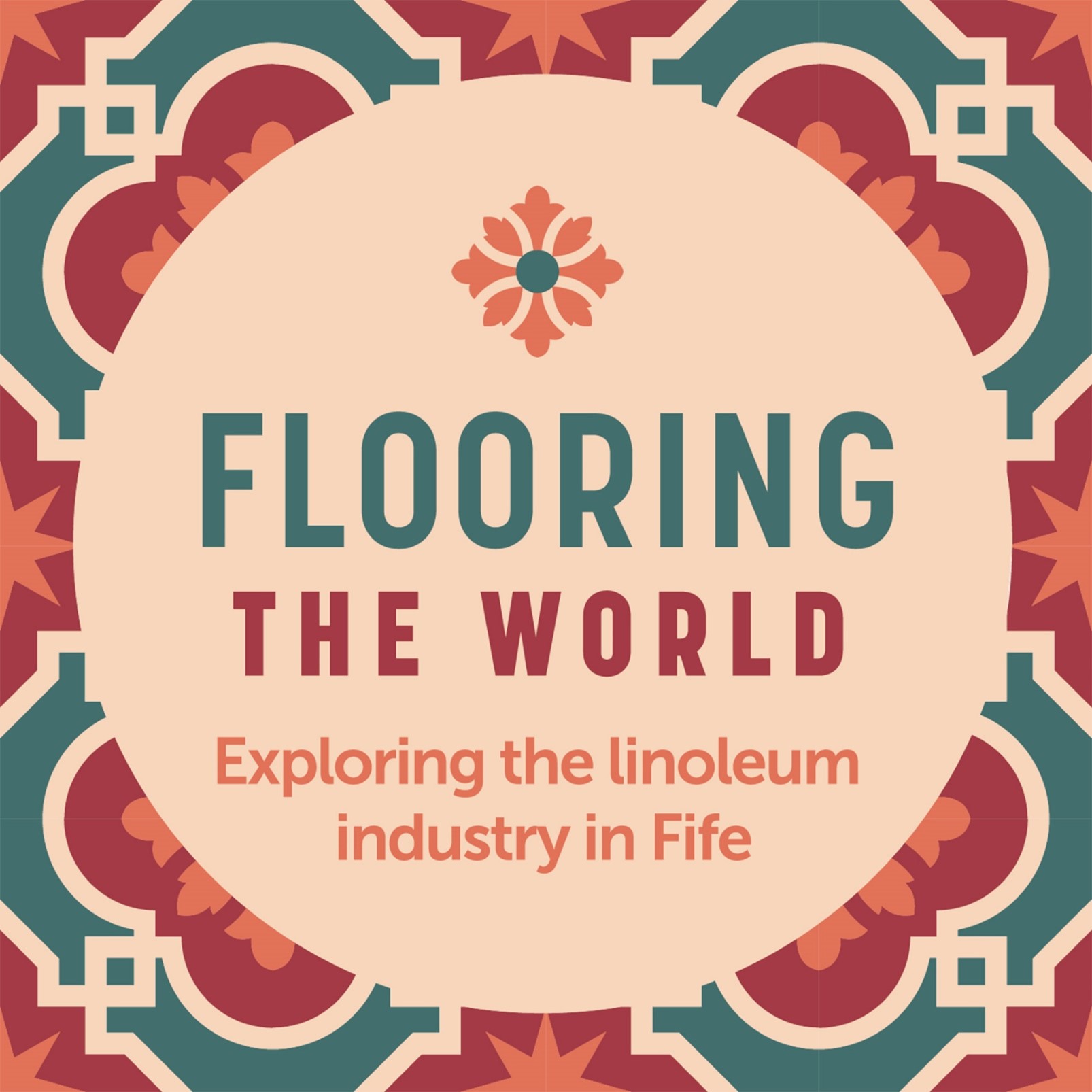
![]()
`HORSES` BY MIMA ROBERTSON, born 1901
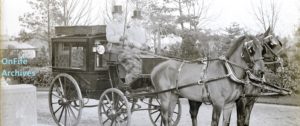
Looking back on my childhood it seems that horses and ponies played an important part in it. John Goodall had a large livery-stable, which provided cabs for the station – luggage on the roof – carriages or landaus for special, with sometimes two horses, gigs and pony-carts, hearses with handsome black horses decked out with black plumes. Father used to hire a Shetland pony for me to ride when I was about five but that did not last long as Mother was afraid I would fall off and injure myself. (Later I got a bicycle on which I performed far more hazardous feats – tramlines made cycling dangerous as it was easy to catch ones front-wheel in one when speeding down the steep Townhill Road).
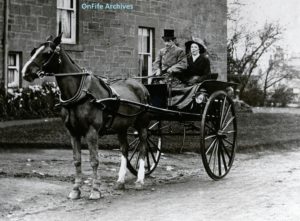
But my great delight was when Father summoned a `trap` from Goodall`s, perhaps in a late summer afternoon when he had returned from the office. This was a lightweight vehicle with two high wheels and a seat for two perched up behind the dashboard and usually a mettlesome animal between the shafts. With a rug round my black-stockinged legs and my feet not touching the floor I would sit by Father`s side while he, expertly handling the reins and the slender whip, would take us out into the country, down to Limekilns perhaps and round by Saline. Then, as there was very little traffic on the roads, I was allowed to experience the thrill of driving the horses myself, learning to hold the reins properly as we went along at a smart pace that only slackened when climbing a hill. That was a real treat and I`m sure Father enjoyed it as much as I did.
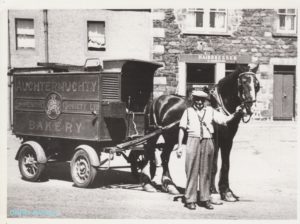
Then there were the tradesmen`s horses, tramping down the avenue to the yard where they took sugar from me while the baker – Allans, with a very smart van high-sided with gold lettering on red paint – or the butcher or the grocer had a chat with the housemaid at the back door. Our Doctor Fleming who had a small brougham in winter, an open Victoria in summer, also made frequent calls. His coachman, Peter McArthur, was a firm friend of mine and he sometimes took me off for a turn round the Park while the doctor was taking Mother`s pulse. He was never in a hurry and never complained when we kept him waiting. Changed days indeed!
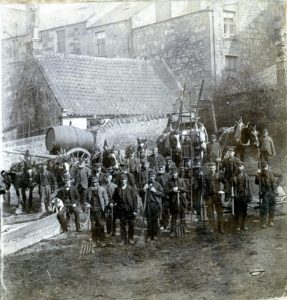
Dunfermline Cleaning gang with horses
Ashes and house-refuse were collected by another horse-drawn vehicle belonging to the town corporation from the stone-built rubbish-container at the top of the garden between the greenhouse and the wash-house. I met other horses on my way through the town and often stopped for a chat as they stood patiently by the pavement. There were always two or three horse-drawn cabs waiting at the Lower Station – in those days Dunfermline was an important railway-junction and one could take trains to Edinburgh, Perth, Stirling, Alloa, St. Andrews, etc. at frequent intervals. The bus that went to Limekilns and Charlestown was horse-drawn and for some years after the `14 War could be found waiting at the Glen gates near the Abbey.
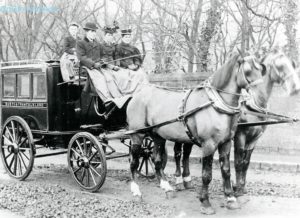
When I was about eleven Mother and I stayed one summer holiday at the Athol Palace, Pitlochry, and went on a wagonette to Braemar. There were four horses, passengers inside and out, and when we reached the Devil`s Elbow everyone except the driver had to walk up – and later down – the steep curves of the road. I was on the box beside the driver – trust me! – and was allowed the honour of holding the reins for a short spell. Driving four horses, spanking along – I have never forgotten it.
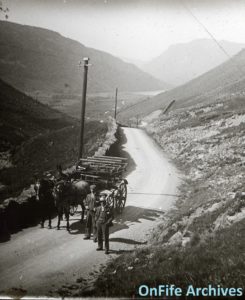
Thanks to Cupar Local Studies for the majority of the photographs.
NOTE ON MIMA ROBERTSON
Mima Robertson was born in 1901 to John Whyte Robertson and his wife Jemima Taylor and was baptised Jemima Simpson Taylor Robertson. Her father worked for the family firm of Hay and Robertson, linen and cotton manufacturers, and her mother was the daughter of John Taylor a West Indian merchant. The couple already had two children, Margaretta born in 1889 and William born in 1893. In 1891 the family lived
at Dunsloy Villas, New Row, in 1901 at 3 Comely Park Place, and from about 1906 at Witchbrae, Townill Road. Witchbrae had been built in about 1860 for the Hay family and was advertised for sale in 1926 as a `fine dwelling house` set in two acres of grounds with excellent views to the south. It was lit by electricity, had several public rooms, six bedrooms, bathrooms, two bedrooms and a bathroom for the maids and numerous utility rooms and outbuildings. The Robertsons kept at least three female servants as well as the outdoor staff.
After an early education at Roseberry House, a private school in the Masonic Lodge, New Row, Miss Robertson was sent to boarding-school. She was so unhappy there that she was brought home to be educated by a governess. The governess, apparently an inspiring teacher, had taught classics at a boys` school and now she taught Latin to Mima, who found it stood her in good stead in her writing.
Mima had written stories from early childhood and when she was 19 received her first payment, 20 shillings from Punch for a humorous article. She loved to travel especially to Brittany and in 1926 she had a story called A Change of Air, set between Brittany and Dunfermline, accepted by a London agent and publishers, who changed the title to The Leopard`s Skin. Other novels with a Dunfermline connection were The Sport of Circumstance and Bitter Bread , while After Stormy Seas was again based in Brittany and Music in the Air in Gottland, the Baltic island, also a holiday destination.
Then followed two historical novels under the name `Alison Taylor`, Alison because it was Scottish and Mima liked it better than her own, and Taylor, her mother`s maiden name. For a change, Evil Enchantment of 1930 was a psychological thriller which she felt would have made a good film.
In the early 1930s when her writing had become a real necessity Miss Robertson was invited to contribute serials to the magazines run by Leng Publications of Dundee, particularly the People`s Friend. She was associated with the People`s Friend for some 40 years and found that writing to order involved a strict routine unlike the free-and-easy hours she had been used to. She continued to write novels and in 1953 published The Castilian, a historical novel about William Kirkcaldy of Grange, who was executed for his attempt to hold the besieged Edinburgh Castle for Mary Queen of Scots.
Mima Robertson had talents other than writing. She played first violin in Dunfermline Amateur Orchestra and was an artist and a needlewoman. She captained the Dunfermline Tennis Club ladies and became President of the Dunfermline Soroptimists. Miss Robertson never married and during the depression of the 1930s, when the family fortunes plummeted, the income from her writing became even more important. From Witchbrae, Mima and her parents moved to 9 Cameron Street where her mother died in 1944 and her father in 1959. Miss Robertson then moved to a flat at 15 Cameron Street and it was here in 1979 that she wrote her magnum opus Old Dunfermline and where she died in 1985 aged 83.
In Miss Robertson`s article on horses, the house referred to is Witchbrae and one of the six bedrooms probably became the schoolroom and what Miss Robertson called `My Room`. `Neil` was the gardener Neil McLean, and `Miss Nimmo` possibly the `nurse and sewing maid for one girl 4½ years` that Mrs. Robertson advertised for in 1906. Or perhaps `Miss Nimmo` was the governess who did sewing as well. The sources for this biography come from various on-line genealogy and newspaper sites, from Dunfermline Press, March 13 1970 (largely reproduced in Hugh Walker`s The History of Hay and Robertson, 1995) and Miss Robertson`s papers, which include (possibly unpublished) stories and plays, and are currently being archived at Dunfermline Carnegie Library but are not yet catalogued.
This is the second blog from our fantastic volunteer Suzie, in celebration of International Women’s Day
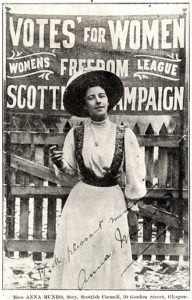
Anna Munro
Anna Gilles Macdonald Munro was born in Glasgow in 1881 and died in 1962 . Her father was a school master and the family lived in Edinburgh until 1892 when Anna’s mother died and then she and her sister, Eva, moved to Dunfermline to live with her paternal Aunt and her husband, Pastor Jacob Primmer.
Having worked for three years for The Sisterhood of the Poor Movement in the East End of London, Glasgow and Edinburgh, Anna was very moved by what she saw. A lifelong supporter of the Labour Party, she served as both chair and president of her local committee. Her fight for female franchise was compassionately rooted in helping women in poverty.
Anna joined the Women’s Social and Political Union (WSPU) in 1906 and became its organiser in Dunfermline. However the WSPU was becoming less democratic and there were concerns that its leadership under Emmeline and Christabel Pankhurst was becoming dictatorial. Anna and several members, including Charlotte Despard and Teresa Billington-Greig broke away and created the Woman’s Freedom League (WFL).
Teresa Billington-Greig was the first Suffragette sent to Holloway. Charlotte Despard was the first woman to refuse to pay taxes as a protest, an action which quickly inspired others to form the Women’s Tax Resistance League (these activities were expanded upon in Apr 1911 when the WFL passed a resolution to boycott the national census protesting against the omission of women’s suffrage for the Kings Speech sending copies of the resolution to Asquith and Churchill. Women householders either spoilt or failed to complete their census forms) In 1907 Anna became Teresa Billington Greig’s personal secretary.
The Women’s Freedom League grew rapidly, and soon had sixty branches throughout Britain with an overall membership of around 4,000 people. This was over twice the size of the WSPU. The WFL also established its own newspaper, “The Vote”
The WFL classed themselves as a militant organisation (over 100 of their members were sent to prison after being arrested on demonstrations or refusing to pay taxes), but unlike the WSPU they refused to attack people or property other than ballot papers. Their actions included protests in and around the House of Commons and other acts of passive civil disobedience such as payment of taxes; their principal being ‘no tax without representation’. WFL activities in 1908 included attempts to present petitions to the king and have deputations received by cabinet ministers while further protests were held in the House of Commons such as Suffragettes chaining themselves to the grille in the Ladies gallery.
In January 1908 Anna took part in a deputation to see Cabinet Minister Richard Haldane. The WFL had petitions protesting against the omission of Women’s Suffrage from the King’s Speech and asked him to use his vote to get the measure passed. When Haldane refused to come out to meet them Anna pinned a large “Votes for Women” flag on the door and told the crowd “OK we will wait for him” and addressed the crowd. The police attempted to move her on and suggested she “go and buy some chocolates” and Anna accused them of impudence, carried on addressing the crowd and was arrested. At her trial she stated “I have come from Scotland for this purpose. I lost my hat yesterday in the crowd, trying to present petition to the King.” On reporting the trial the Dundee Courier claimed her to be “an excellent and fluent speaker”. She was imprisoned in Holloway Prison for six weeks.
A letter in the Aberdeen Press & Journal 5th February 1908 from Pastor Jacob Primmer, Anna’s uncle, to the Home Secretary (Herbert Gladstone) :-
“The Manse, Kingseathill, Dunfermline, 31 Jan 1908
Dear Sir
As the uncle of Miss Anna Munro who at Westminster Court yesterday , got the cruel and vindictive punishment of six weeks imprisonment – while for the same political offence the sentence at Marylebone was 40 shilling or twenty-one days imprisonment and 40 shilling, or one month, as a Suffragist – allow me to point out that for long she has been in delicate and precarious health; that only four weeks ago she fell down in a faint in a Glasgow street; that imprisonment will be most serious in its consequence; that therefore you should order her liberation from prison, and that until that be done she should be kept in the infirmary.
On 8th February E Blackwell responded on behalf of the Secretary of State saying he could find no grounds for releasing her. However her uncle had already received a telegram (S7) saying that she was free after someone had paid surety of £20 (Dundee Courier 12th Feb 1908).
Jacob Primmer responded that his niece had been arrested for
“the awful crime of knocking up some of your fellow Cabinet Ministers at 9:30am and holding outside public meetings until they made their appearance. It was my niece who put the question to the Prime Minister in Dunfermline on 22nd October last –
‘As the Prime Minister believes in Women’s suffrage would he suggest some method we could adopt in order to get our enfranchisement soon? He said I think they ought to go on agitating and holding meetings and pestering people as much as they can, as all other men and women who are interested in public questions have to do.’
Is not, therefore, outrageous and the playing of the tyrant keep them in the common prison among the vilest the nation for following the advice of your superior—the head the Government? Remember that cruelty and intolerance never pay, even the part of a Home Secretary. Is it not farcical to charge a frail and weak young lady with resisting number of elephantine, six feet five inches policemen? And for this awful crime to suffer six weeks Holloway Prison? Doctors and others Dunfermline can bear testimony to the delicate and precarious health of my niece, yet you say that she ‘is fair general health’. This is emphatically contradicted in letter received from her this evening. She writes—‘you know, I came out of Holloway last night after being in ten days. It was either case of that or hospital!’ And she complains suffering from a frightful headache. It would be well if in future you got some honest, reliable person to give you information to the condition those tyrannically cast into prison. I write in the interests of fair play and protect, against your turning the administration of the law into farce.”
On returning to Dunfermline a suffragette meeting was held to welcome Anna back. The principal speakers were “Anna Munro, Dunfermline and Mrs Sanderson, Forfar” both who had suffered imprisonment in Holloway. Anna stated that since her last appearance she had “lost her character and had become a gaolbird”. Describing her arrest, she said they were not guilty of the dreadful things that were read of in the papers. They did not shout, they did not scream; it was an exceedingly dignified matter altogether. At Mr Haldane’s house they pinned a “Votes for Women” flag on the door. Six policemen came along, and they went with them very properly, and did not resist in any way. There was not a single woman allowed into the Court. They asked if she wished to say anything her own defence but when she- had opportunity to say anything was simply shouted down. She did not hear the sentence; she heard murmur from the bench, and then she was removed.
Anna was good at addressing meetings; she was eloquent and charismatic and spoke without notes at many meetings and in December 1908 Anna became the WFL organising secretary in Glasgow. The Scottish Council of the Women’s Freedom League was based at 30 Gordon Street, and also ran a tearoom and bookshop at the Suffrage Centre, originally in Sauchiehall Street and later in St George’s Road.
In 1910 there is a picture/photo of her in prison “garb” saying that she will take active part in the campaign against Mr Churchill during the election. Churchill was first elected MP for Dundee in 1908 after failing to keep his Manchester seat. His re-election in Dundee was fought by the WFL who organised many meetings in December. Churchill did not back women’s suffrage. When asked why he wouldn’t give women the vote or political rights he responded “you have political rights as exercised through your husband.” In December 1910 Churchill visited Dundee. On the 6th December 1910, at the Corn Exchange in Albert Square Dundee, Charlotte Despard and Anna spoke out against Churchill for acting against Liberal principles. Anna is quoted as saying that when Churchill came to Dundee he said ‘Trust me Ladies I am your friend’ but “the ladies did not trust him and his subsequent action proved them correct”.
Also that week in Dundee she spoke at ten different protest meetings at King’s Theatre, Caird Fountain, Baxter’s Works, the YMCA , the High School Gate, Cox’s works, at the Foot of the Town Hall and other venues. She urged the crowds “Put not your trust in princes, neither put in party politicians, and no account put it in Mr Winston Churchill.”
‘
On the day of the election, 25th January, Anna and other suffragettes followed Asquith as he visited polling stations. She warned people that a vote given to him was a vote given for women being sent prison. Petitions advocating votes for women were canvassed at all the polling stations. Anna complained that she was kicked and struck by the Liberal stewards saying ‘that was owing to the bad influence of Mr Asquith’ while at Tayport the women there flocked to the WFL standard and booed and hissed as he left the meeting. She described Mr Asquith as ‘a canting hypocrite and a humbug’
April 19th 1911 in the rooms of the Democratic Unionist Association Anna delivered a lecture to a large crowd on ‘The Women of Today’ –saying the goal society was moving towards was the realisation of the humanity of women not just her duty to marry and bring up children but to develop and use her god given talents.
The WFL were opposed to violent campaigning and in keeping with this organised a 400 mile walk from Edinburgh to London. It was led and organised by actress Florence Gertrude de Fonblanque. The peaceful protest set off on 12th October 1912 from Charlotte Square in Edinburgh marching down Princes Street and was sent off with the largest crowd the WFL had so far attracted. Anna spoke at the meeting saying the women’s movement was more than a passing phase. The aim of the walk was to gather signatures on route to a petition stating: ‘We, the undersigned, pray that the Government will make itself responsible for a Bill to give votes to women this session’. Their first stop on their walk was Musselburgh. The walkers were dressed in brown uniforms and brown felt hats with green cockades and heavy footgear, marching beneath a banner announcing the route and object of the march. They were escorted by a covered van.
Over fifty women marched on to Musselburgh where about 2000 people heard addresses from speakers. The public were attentive and on the whole friendly; however a few missiles were thrown including a bad egg and a few rotten apples. Anna was one of six women who completed the walk. They reported that the only unpleasant experience was in Peterborough where on 8th November a rally of ‘thousands’ of people was disrupted when the stage was rushed and large quantity fireworks were thrown at the speakers and they had to be accompanied out by the police.
The walkers entered London on the 16th November with a welcome parade, apparently over a quarter of a mile in length. It was attended by four or five thousand suffragettes both male and female who were led to Trafalgar Square amidst the stirring strains of ‘ See the Conquering Hero Comes’ and Women’s March composed by Dr Ethel Smyth; a friend of Emmeline Pankhurst. At Trafalgar Square a considerable crowd of people awaited. Mrs de Fonblanque took the petition to Downing Street with the cart containing the signatures; they were admitted although a police cordon had been drawn. At No 10 they were told the petition would be passed to Asquith.
The Prisoner’s Temporary Discharge for Ill Health Act, commonly referred to as the Cat and Mouse Act, was an Act of Parliament passed in Britain under Herbert Henry Asquith’s Liberal government in 1913 when Reginald McKenna was Home Secretary. Asquith was the MP for East Fife and fiercely opposed to women’s rights. The Women’s Freedom League posted a leaflet to “The Police Forces of Britain” urging the police to disregard the bill and to refuse to re-arrest Suffrage prisoners discharged for ill health. It was signed by Anna along with Charlotte Despard, E. Knight, Nina Boyle, A. Underwood and Kathleen Tanner. She also joined a deputation to McKenna along with Eunice Murray to complain about the conditions in jail for poor people. Eunice Murray was president of the WFL in Glasgow and often gave speeches alongside Anna and was the first women to stand for parliamentary election in Scotland.
While attempting to address a meeting at Hyde Park, London, on 5th May 1913 Nina Boyle, head the political and militant department of the Women’s Freedom League, and Anna, were arrested and taken to Crawford Place Police Station. They were jailed in Holloway for 14 days in default of payment of £20 for obstructing the free passage of the highway at Marble Arch, London. After being released, on 19th May, she attended the police station at Marylebone on Monday to bring to the attention of the authorities the conditions in the police van where prisoners of both sexes were conveyed and the behaviour of both men and women were violent, horrible and there were scenes of indecency.
Anna travelled to throughout England to give talks in the WFL horse-drawn caravan, and on one such trip to Thatcham, near Reading, she met Sidney Ashman whom she married in 1913 S1. In December 1918 she became president of the Reading Branch of the WFL
Anna Munro was a supporter of the temperance movement and president of the National British Total Abstinence Movement. After the First World War she became a magistrate in England and president of the Women’s Freedom League.
To find out the sources used in this research please contact localstudies.dunfermline@onfife.com
